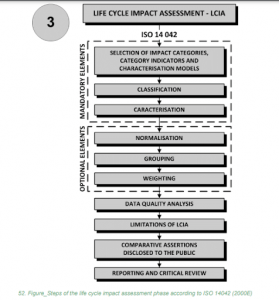Lesson 5: Life Cycle Impact Assessment (LCIA) and LIFE CYCLE INTERPRETATION
Welcome to the second part of our series on Life Cycle Assessment (LCA). In this lesson, we will delve into the Life Cycle Impact Assessment (LCIA) phase and explore the crucial process of Life Cycle Interpretation.
- LCIA: Life Cycle Impact Assessment
The LCIA phase, which is the third step in the LCA process as per ISO 14042 (2000E), involves a series of important steps:
- Selection of Impact Categories: In this step, we choose the environmental impact categories, category indicators, and characterization models.
- Classification: We assign Life Cycle Inventory (LCI) results to specific impact categories.
- Characterization: This step quantifies the impacts of inventory parameters into specific impact categories.
- Normalization: Normalization provides a way to understand the regional or global significance of the modeled results.
- Weighting: Weighting helps us determine the social significance of different impact categories.
- Data Quality Analysis: Ensures the quality and reliability of the data used in LCIA.
- Limitations of LCIA: While not explicitly addressed in this phase, these limitations are often covered during the LCA’s initial phases.
- Comparative Assertions Disclosed to the Public: LCIA results can influence decisions made public, and it is essential to communicate these effectively.
- Reporting and Critical Review: Similar to the earlier phase of LCA, these aspects are critical for transparency and credibility.
In LCIA, we convert the environmental load from the product system into environmental impacts, such as global warming or acidification. This process involves classifying and characterizing inventory parameters, which may impact multiple categories. Normalization and weighting provide insights into the significance of these impact categories.
Classification and Characterization Approaches
LCIA employs two main approaches:
- Problem-Oriented Approach (Mid Point Approach): Classifies flows based on the environmental impacts they contribute the most to.
- Damage-Oriented Approach (End Point Approach): Groups categories based on the end results, such as adverse effects on human health or ecosystems.
Some LCIA Methods Include:
- CML (Leiden University, The Netherlands): Problem-oriented method with categories like Global Warming Potential (GWP) and Ozone Depletion Potential (ODP) based on IPCC factors.
- TRACI (EPA): A problem-oriented method primarily used in the US.
- SETAC – Europe Working Group on Impact Assessment: Proposes basic impact categories and indicators based on the mid-point approach.
- ECO-INDICATOR 99: A damage-oriented method, slightly modified compared to SETAC.
- EDIP (Environmental Design of Industrial Products): Utilizes the mid-point approach.
- OPM (Oil Point Method): Uses Energy Input as an indicator for Environmental Load.
- EPS (Environmental Priority Strategies): Focuses on strategies for environmental conservation.
Additionally, there are methods that consider stakeholder (consumer) requirements, like QFD and EQFD.
Selection of Impact Categories, Indicators, and Characterization Models
To determine the contribution of LCI results to impact categories, you must select relevant impact categories, indicators, and characterization models. Impact categories can be categorized as baseline, study-specific, or other.
Classification of Emissions Associated with Impact Categories
Common environmental impact categories include Global Warming Potential (GWP), Ozone Depletion Potential (ODP), Acidification Potential (AP), Eutrophication Potential (EP), and more. Different categories help us evaluate various environmental impacts and their relative significance.
Characterization
Characterization involves determining the relative contribution of each inventory parameter using Characterization Factors (CF) or Equivalence Factors (EF). For example, in the case of global warming, the CF compares greenhouse gases like carbon dioxide (CO2) and methane (CH4). Methane is significantly more potent as a greenhouse gas than carbon dioxide.
Normalization
Normalization allows the comparison of different environmental impact categories. It involves calculating contributions relative to normalization references, which can be local, regional, or global, depending on the impact category.
Grouping
Grouping combines impact categories into sets, aiding interpretation. It can be done through sorting or ranking.
Weighting
Weighting assigns significance to different impact categories based on social, ethical, or political values. It allows for a more realistic representation of environmental impacts.

- Life Cycle Interpretation
The fourth and final phase of the LCA process is Life Cycle Interpretation, outlined in ISO 14043 (2000). This phase includes:
- Identification of Significant Issues: Based on LCI and LCIA results, this step highlights important concerns.
- Evaluation: This step includes completeness, sensitivity, and consistency checks.
- Conclusions, Recommendations, and Reporting: The results are interpreted to make informed decisions and recommendations.
Conclusion
- LCIA is a vital step in LCA, where environmental impacts are assessed, categorized, and quantified. It involves classification, characterization, normalization, weighting, and more.
- LCIA methods can be problem-oriented (mid-point) or damage-oriented (end-point), offering various approaches to assessing environmental impacts.
- Selection of impact categories, indicators, and characterization models is essential for effective LCIA.
- Characterization factors and normalization references help compare different impact categories, providing insights into the significance of environmental impacts.
- Life Cycle Interpretation concludes the LCA process, allowing us to identify significant issues, evaluate results, and make informed decisions for sustainability.